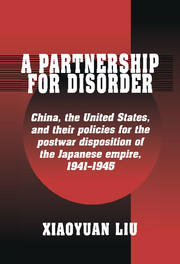 A Partnership for Disorder
A Partnership for Disorder Book contents
- Frontmatter
- Contents
- Acknowledgments
- Note on romanization
- Abbreviations
- Introduction
- 1 The making of an alliance
- 2 The issue of postwar Japan
- 3 China's lost territories
- 4 Korea's independence
- 5 The road to Cairo
- 6 A divisive summit
- 7 Yan'an and postwar East Asia
- 8 Diplomacy without action
- 9 Erosion of a partnership
- 10 The Manchurian triangle
- 11 Bargaining at Moscow
- 12 Epilogue: The crisis of peace
- Appendix I Guiding Plan for Helping the Korean Restoration Movement
- Appendix II Two Chinese documents of the Cairo Conference
- Bibliography
- Index
Introduction
Published online by Cambridge University Press: 20 October 2009
- Frontmatter
- Contents
- Acknowledgments
- Note on romanization
- Abbreviations
- Introduction
- 1 The making of an alliance
- 2 The issue of postwar Japan
- 3 China's lost territories
- 4 Korea's independence
- 5 The road to Cairo
- 6 A divisive summit
- 7 Yan'an and postwar East Asia
- 8 Diplomacy without action
- 9 Erosion of a partnership
- 10 The Manchurian triangle
- 11 Bargaining at Moscow
- 12 Epilogue: The crisis of peace
- Appendix I Guiding Plan for Helping the Korean Restoration Movement
- Appendix II Two Chinese documents of the Cairo Conference
- Bibliography
- Index
Summary
The Asian–Pacific dimension of World War II is an extremely complicated and significant aspect in the international history of this century. This is so not only because the Asian–Pacific conflict encompassed the largest geographic theater of the war, but also because the war fought against Imperial Japan involved forces that combined political, racial, ideological, and cultural differences. If one can liken the military dimension of the war to a two-sided chess game, on the political–diplomatic front the belligerents were playing a Chinese checker game that almost continuously redivided them into many sides. This study examines one aspect of the wartime American–Chinese relationship that has been largely overlooked by the existing historiography of World War II: the American and Chinese governments' wartime cooperation in conceiving of a new international order for postwar East Asia. Focusing on this one subject, the study cannot avoid being cursory on certain other important issues regarding the Asian dimension of World War II.
By tracing those paths in which the American and Chinese war and peace aims for East Asia were constructed and then exploring the two governments' efforts to coordinate their postwar programs, this inquiry bears some resemblance to three groups of scholarly works pertinent to the international relations of World War II. The first is the literature on the wartime inter-Allied diplomacy for reorganizing peace. In these studies, China's role is usually minute.
- Type
- Chapter
- Information
- A Partnership for DisorderChina, the United States, and their Policies for the Postwar Disposition of the Japanese Empire, 1941–1945, pp. 1 - 9Publisher: Cambridge University PressPrint publication year: 1996
